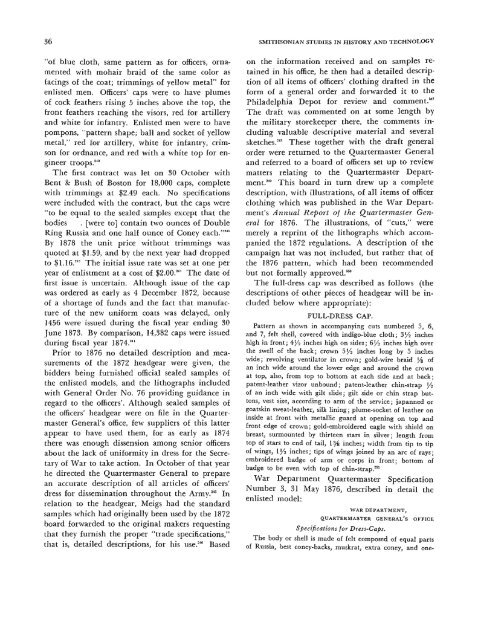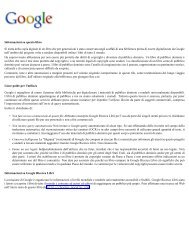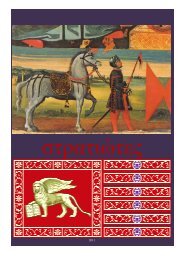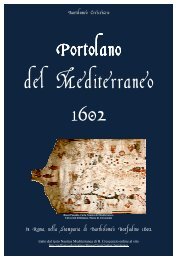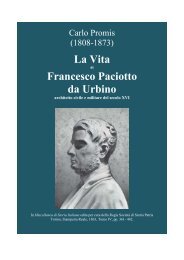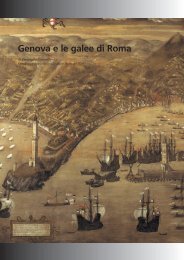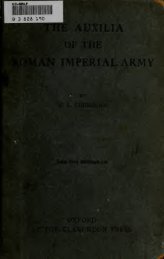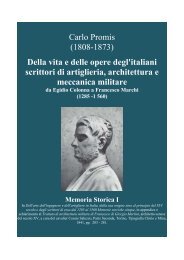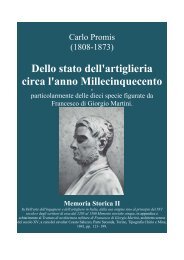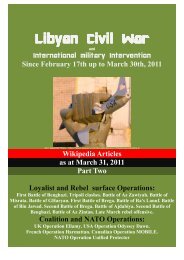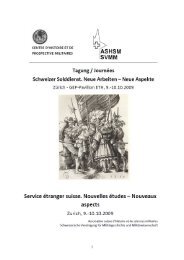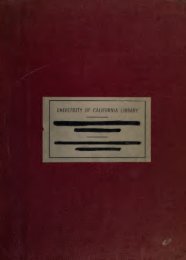36 SMITHSONIAN STUDIES IN HISTORY AND TECHNOLOGY"of blue cloth, same pattern as for officers, ornamentedwith mohair braid of the same color asfacings of the coat; trimmings of yellow metal" forenlisted men. Officers' caps were to have plumesof cock feathers rising 5 inches above the top, thefront feathers reaching the visors, red for artilleryand white for infantry. Enlisted men were to havepompons, "pattern shape; ball and socket of yellowmetal," red for artillery, white for infantry, crimsonfor ordnance, and red with a white top for engineertroops.""The first contract was let on 30 October withBent Sc Bush of Boston for 18,000 caps, completewith trimmings at .12.49 each. No specificationswere included with the contract, but the caps were"to be equal to the sealed samples except that thebodies . [were to] contain two ounces of DoubleRing Russia and one half ounce of Coney each."'"By 1878 the unit price without trimmings wasquoted at .11.59, and by the next year had droppedto .11.16.'" The initial issue rate was set at one peryear of enlistment at a cost of .f2.00.^' The date offirst issue is uncertain. Although issue of the capwas ordered as early as 4 December 1872, becauseof a shortage of funds and the fact that manufactureof the new uniform coats was delayed, only1456 were issued during the fiscal year ending 30June 1873. By comparison, 14,382 caps were issuedduring fiscal year 1874.'^'Prior to 1876 no detailed description and measurementsof the 1872 headgear were given, thebidders being furnished official sealed samples ofthe enlisted models, and the lithographs includedwith General Order No. 76 providing guidance inregard to the officers'. Although sealed samples ofthe officers' headgear were on file in the QuartermasterGeneral's office, few suppliers of this latterappear to have used them, for as early as 1874there was enough dissension among senior officersabout the lack of uniformity in dress for the Secretaryof War to take action. In October of that yearhe directed the Quartermaster General to preparean accurate description of all articles of officers'dress for dissemination throughout the <strong>Army</strong>.'" Inrelation to the headgear, Meigs had the standardsamples which had originally been used by the 1872board forwarded to the original makers requestingthat they furnish the proper "trade specifications,"that is, detailed descriptions, for his use.'^" Basedon the information received and on samples retainedin his office, he then had a detailed descriptionof all items of officers' clothing drafted in theform of a general order and forwarded it to thePhiladelphia Depot for review and comment.^'The draft was commented on at some length bythe military storekeeper there, the comments includingvaluable descriptive material and severalsketches."' These together with the draft generalorder were returned to the Quartermaster Generaland referred to a board of officers set up to reviewmatters relating to the Quartermaster Department.""This board in turn drew up a completedescription, with illustrations, of all items of officerclothing which was published in the War Department'sAnnual Report of the Quartermaster Generalfor 1876. The illustrations, of "cuts," weremerely a reprint of the lithographs which accompaniedthe 1872 regulations. A description of thecampaign hat was not included, but rather that ofthe 1876 pattern, which had been recommendedbut not formally approved.'^The full-dress cap was described as follows (thedescriptions of other pieces of headgear will be includedbelow where appropriate):FULL-DRESS CAP.Pattern as shown in accompanying cuts numbered 5, 6,and 7, felt shell, covered with indigo-blue cloth; 3/a incheshigh in front; 4/2 inches high on sides; 6/2 inches high overthe swell of the back; crown 5/2 inches long by 5 incheswide; revolving ventilator in crown; gold-wire braid Ys ofan inch wide around the lower edge and around the crownat top, also, from top to bottom at each side and at back;patent-leather vizor unbound; patent-leather chin-strap Y^of an inch wide with gilt slide; gilt side or chin strap buttons,vest size, according to arm of the service; japanned orgoatskin sweat-leather, silk lining; plume-socket of leather oninside at front with metallic guard at opening on top andfront edge of crown; gold-embroidered eagle with shield onbreast, surmounted by thirteen stars in silver; length fromtop of stars to end of tail, lYs inches; width from tip to tipof wings, 1/2 inches; tips of wings joined by an arc of rays;embroidered badge of arm or corps in front; bottom ofbadge to be even with top of chin-strap.*"War Department Quartermaster SpecificationNumber 3, 31 May 1876, described in detail theenlisted model:WAR DEPARTMENT,QUARTERMASTER GENERAL'S OFFICESpecifications for Dress-Caps.The body or shell is made of felt composed of equal partsof Russia, best coney-backs, muskrat, extra coney, and one-
NUMBER 3037half (5/2) part of washblow. It weighs, uncovered, two andthree-fourths (2?4) to three (3) ounces, according to size.Front vertical about three and one-half (3/a) inches high;back five and one-half (5/2) inches long, rises upward andforward in a convex sweep, and meets the crown at a pointone and one-eighth (1^) to one and one-fourth {1J4)inch higher than the point where it meets the upper edgeof the front.The crown is slighly oval, five and one-fourth (5^4)inches in diameter from front to back, four and one-half(4/2) inches across. Ventilator in center of crown. At thefront edge is an opening, bound with a thin strap of enameledmetal, to admit the stem of the pompon, which isalso held in position by a small leather socket sewed to theinside of the cap-front, about one-half {Y2) inch belowthe crown.The body is covered with fine wool-dyed indigo-bluecloth, braided around the upper edge immediately belowthe crown, around the lower edge one-fourth (J4) to fivesixteenths(%6) of an inch above the latter: also straightdown the back, and in a straight slanting line on both sides,equidistant from back and front seam. This braiding isworsted three-sixteenth (%6) of an inch wide, and of thefollowing colors: for infantry, sky-blue; engineers and artillery,scarlet; ordnance, crimson; commissary sergeants, gray;hospital stewards, green. A visor of heavy enameled leather,straight and horizontal, front edge slightly convex, sidesstraight, corners rounded, inner edge following the shapeof the cap on both sides, ending in a point about five (5)inches from front seam.On each side, immediately behind the end of visor, is itsmall regulation brass button for chin-strap.The latter is made of thin enameled leather five-eighths(Ys) of an inch wide, in two parts, eight and one-half (8^2)to nine (9) inches each, and arranged to be lengthened andshortened, as described for helmet chin-strap. Sweat-leather,one and three-fourths (1 ^) to two (2) inches wide ofBelgium leather. In front, immediately below the crown, isa brass eagle, and below the latter the badge of the corpsor arm of services.Sizes same as of helmets.Adopted May 31, 1876.Pompons for Dress-Caps—Of fine worsted, firmly made ona woodblock.Nap well raised and close. To be pear-shaped, three (3)inches long, one and three-fourths (1 %) inch in diameterat bottom, and one (1) inch at top. Under the center of thebottom is a brass half sphere about eleven-sixteenths (^^e)of an inch in diameter, from which protrudes a stem three(3) inches long, made of strong copper wire.Color of pompons for infantry, white; artillery, scarlet;engineers, lower half scarlet, upper half white; ordnance,crimson; commissary sergeants, gray; hospital stewards,green.Adopted May 31, 1876.M. C. MEIGS,Quartermaster General.Bvt. Major General, U.S.A."'A number of examples of the cap have been examined,including six sealed samples (Figures 25,26) and three officers' models (Figure 27) whichcan be included in the same category. Two of theselatter, one made by Horstmann and the other byBent & Bush, carry attached a label reading:1747 Qr Mr Gens Office1874 Received Jun 17 1875The third carries a label in a handwriting verysimilar to General Marcy's:'s Uniform cap for. . . .ents of foot artillery & Infy. recommended bythe Board for revision of <strong>Army</strong>RegulationsR B MarcyI. Genl & Presdt. of BoardThe latter cap carries the maker's label of Warnock& Co. in the crown and definitely must be consideredthe original or one of the original modelssupplied the board.The enlisted models all follow the 1876 specificationswithin allowable tolerances, while the officer'sexamples, the three mentioned above plusseveral others, are closer in detailed measurementsto the one-half scale lithographs. The differencesbetween the two are not great, but they are consistent;height in front for officers, 37/8 inches, forenlisted men, 3i/4; height in rear, for officers, 6i/^inches, for enlisted men 5i/^; diameter of crown,for officers, 6 inches, for enlisted men, 514.The regulations prescribed the insignia for thecap only as "gold trimmings" or "yellow metal, accordingto pattern" for officers and enlisted men,respectively. No clear indication was given as toexactly what badge each branch of the service wasto wear, possibly relying on usage that had beenin effect since 1832. In November 1872 the inspectorgeneral prescribed for hospital stewards, ordnance,and engineer soldiers, respectively, a wreathof brass with the letters "U.S.," "O.D.," and "E.G."inside, but said nothing of the badges for the lineunits. This order also prescribed that the capbraid and pompon for hospital stewards was to beemerald green.'*' As late as mid-December thePhiladelphia Depot quartermaster was seeking informationfrom Washington as to the size andpattern of insignia for both headgear and unilornicoat collars. The query brought from the Secretaryof War the endorsement: "Forage caps, badges, and
- Page 1: • ^ - :lP-'L^ry\'^ ^iT
- Page 4 and 5: ABSTRACTHowell, Edgar M. United Sta
- Page 7 and 8: ContentsPagePrefaceiiiThe 1855 Cava
- Page 9 and 10: United States Army Headgear 1855-19
- Page 11 and 12: NUMBER 30report, stated: "The hat p
- Page 13 and 14: NUMBER 30acorns %g inches long and
- Page 15 and 16: NUMBER 30the pattern." The rate of
- Page 17 and 18: NUMBER 30FIGURE 3.—1858 Army hat.
- Page 19 and 20: NUMBER 3011model, number 60 in the
- Page 21 and 22: NUMBER 30 13"the desired modificati
- Page 23 and 24: NUMBER 30 15the sun in the top. The
- Page 25 and 26: NUMBER 30 17FIGURE 8.—1858 forage
- Page 27 and 28: NUMBER 30 19Hardtack and Coffee, ca
- Page 29 and 30: NUMBER 3021FIGURE 11.—a, Brigadie
- Page 31 and 32: NUMBER 30 23short "shell" jacket "f
- Page 33 and 34: NUMBER 30 26broad, securely soldere
- Page 35 and 36: NUMBER 30 27worn in the picture wer
- Page 37 and 38: NUMBER 30 29This communication elic
- Page 39 and 40: NUMBER 30 31FIGURE 17.—"The [Scot
- Page 41 and 42: NUMBER 30 33time for issue in the c
- Page 43: NUMBER 30 35be at too great a dista
- Page 47 and 48: NUMBER 30 39trimmings for all enlis
- Page 49 and 50: NUMBER 30 41ing the upper space for
- Page 51 and 52: NUMBER 30rear one to a correspondin
- Page 53 and 54: NUMBER 30 46FIGURE 29.—1872 enlis
- Page 55 and 56: NUMBER 3047FIGURE 32.—^The Bent &
- Page 57 and 58: NUMBER 3049of strong split-leather
- Page 59 and 60: NUMBER 30 51''""MttfenFIGURE 35.—
- Page 61 and 62: NUMBER 30 53(which he thought might
- Page 63 and 64: NUMBER 30 55FIGURE 38.—Captain Be
- Page 65 and 66: NUMBER 30 57campaign hat for the Ar
- Page 67 and 68: NUMBER 30 59salvage something from
- Page 69 and 70: NUMBER 30 61hat. In June 1899 the P
- Page 71 and 72: NUMBER 3063the left side, pass diag
- Page 73 and 74: NUMBER 30 65.LJU^.."*^..FIGURE 44.
- Page 75 and 76: NUMBER 30 67to be sent to Washingto
- Page 77 and 78: NUMBER 30 69with brass sliding-buck
- Page 79 and 80: NUMBER 30 71FIGURE 48.—Officers'
- Page 81 and 82: NUMBER 3073The adoption of the whit
- Page 83 and 84: NUMBER 3075i >•^\Wiii I ifiiiniim
- Page 85 and 86: NUMBER 30this last model made no pr
- Page 87 and 88: NUMBER 30 79WAR DEPARTMENT,QUARTERM
- Page 89 and 90: NUMBER 3081FIGURE 58.—1864 chapea
- Page 91 and 92: NUMBER 30geon 1880 and Surgeon Gene
- Page 93 and 94: NUMBER 3085FIGURE 63.—1895 forage
- Page 95 and 96:
NUMBER 30 87of not less than 9.24 g
- Page 97 and 98:
AppendixMAKERS OF HEADGEARThe chron
- Page 99 and 100:
List of AbbreviationsAAGAAQMAGAGOAQ
- Page 101 and 102:
NUMBER 3093all OQMG, LS, Clothing,
- Page 103 and 104:
NUMBER 30 95"Jesup to Thomas, 8 Dec
- Page 105 and 106:
NUMBER 3097OQMG, Reg. LR, Clothing,
- Page 107 and 108:
NUMBER 30 99October of 1870. See Me
- Page 109 and 110:
NUMBER 30 101'"* See above, pp. 35-
- Page 111 and 112:
NUMBER 30 103Monroe, Va., in 1878.
- Page 113 and 114:
NUMBER 30 105""Endorsement, 24 May
- Page 115 and 116:
ReferencesThe bulk of the source ma
- Page 117:
M MBIiR 30 10910, No. 355-10, 19 Se


